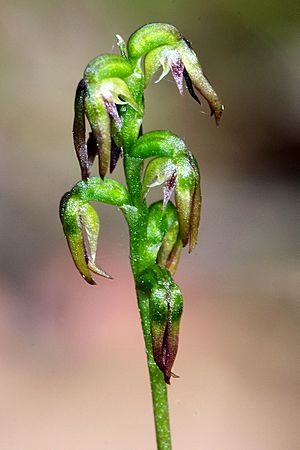Sharp midge orchid facts for kids
Quick facts for kids Sharp midge orchid |
|
|---|---|
 |
|
| Scientific classification | |
| Genus: |
Genoplesium
|
| Species: |
despectans
|
| Synonyms | |
|
|
The sharp midge orchid (also called Genoplesium despectans) is a tiny orchid that grows only in south-eastern Australia. It's also known as Corunastylis despectans there. This special plant has a single thin leaf that joins its flower stem. It can have up to 45 small flowers. These flowers are usually dark purple, or a mix of green and purple.
What Does the Sharp Midge Orchid Look Like?
The sharp midge orchid is a plant that grows from an underground tuber. It lives for many years. It also loses its leaves each year. It has one thin leaf, about 150 to 250 mm (6–10 in) long. This leaf is joined to the flower stem. The free part of the leaf is about 10 to 15 mm (0.4–0.6 in) long.
Up to 45 tiny flowers grow on a stem that is 20 to 40 mm (0.8–2 in) tall. These flowers are dark purple, or green and purple. They hang downwards. Each flower is about 5.5 mm (0.2 in) long and 3 to 4 mm (0.1–0.2 in) wide.
Orchid flowers are often upside down. This means the labellum (a special lip petal) is above the column (the part that holds the pollen). The top sepal (a leaf-like part) is egg-shaped. It is about 3 mm (0.1 in) long and 2 mm (0.08 in) wide. The side sepals are long and narrow. They are about 4 mm (0.2 in) long and 1 mm (0.04 in) wide. These sepals spread apart.
The petals are egg-shaped, about 2 mm (0.08 in) long and 1 mm (0.04 in) wide. They have a pointed tip. The labellum is thick and fleshy. It is about 3 mm (0.1 in) long and 1 mm (0.04 in) wide. It has a sharp point and tiny teeth along its edges. There is a narrow, raised part called a callus in the middle of the labellum. It reaches almost to the tip. These orchids bloom between December and April.
How Did the Sharp Midge Orchid Get Its Name?
The sharp midge orchid was first officially described in 1858. A scientist named Joseph Dalton Hooker gave it the name Prasophyllum despectans. He wrote about it in a book called Flora Antarctica.
Later, in 1989, two other scientists, David Jones and Mark Clements, changed its name to Genoplesium despectans. Then, in 2002, they changed it again to Corunastylis despectans. The second part of its scientific name, despectans, comes from a Latin word. It means "to look down upon."
Where Does the Sharp Midge Orchid Live?
The sharp midge orchid grows in heathlands and heathy forests. You can find it south of Wollongong in New South Wales. It is very common and widespread in Victoria. This orchid also grows in the south-east of South Australia and in Tasmania.

